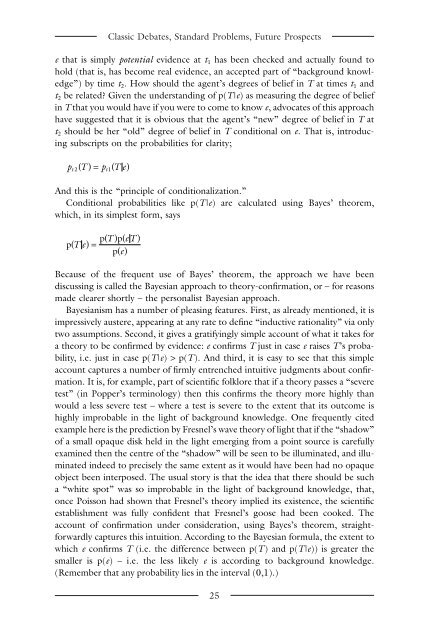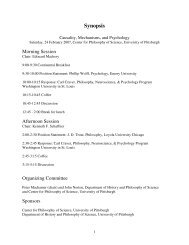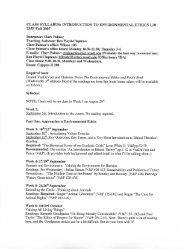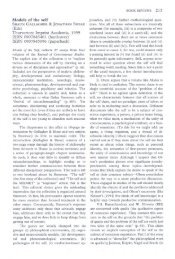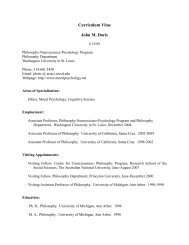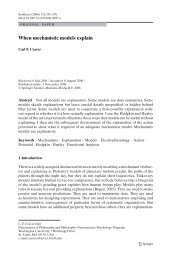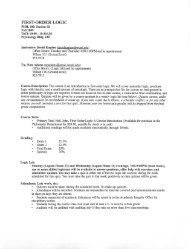The Blackwell Guide to the Philosophy of Science - The Department ...
The Blackwell Guide to the Philosophy of Science - The Department ...
The Blackwell Guide to the Philosophy of Science - The Department ...
You also want an ePaper? Increase the reach of your titles
YUMPU automatically turns print PDFs into web optimized ePapers that Google loves.
e that is simply potential evidence at t 1 has been checked and actually found <strong>to</strong><br />
hold (that is, has become real evidence, an accepted part <strong>of</strong> “background knowledge”)<br />
by time t 2. How should <strong>the</strong> agent’s degrees <strong>of</strong> belief in T at times t 1 and<br />
t2 be related? Given <strong>the</strong> understanding <strong>of</strong> p(T|e) as measuring <strong>the</strong> degree <strong>of</strong> belief<br />
in T that you would have if you were <strong>to</strong> come <strong>to</strong> know e, advocates <strong>of</strong> this approach<br />
have suggested that it is obvious that <strong>the</strong> agent’s “new” degree <strong>of</strong> belief in T at<br />
t2 should be her “old” degree <strong>of</strong> belief in T conditional on e. That is, introducing<br />
subscripts on <strong>the</strong> probabilities for clarity;<br />
p ( T)= p ( T e)<br />
t2 t1<br />
And this is <strong>the</strong> “principle <strong>of</strong> conditionalization.”<br />
Conditional probabilities like p(T|e) are calculated using Bayes’ <strong>the</strong>orem,<br />
which, in its simplest form, says<br />
p( T) p(<br />
eT)<br />
p(<br />
Te)=<br />
p()<br />
e<br />
Classic Debates, Standard Problems, Future Prospects<br />
Because <strong>of</strong> <strong>the</strong> frequent use <strong>of</strong> Bayes’ <strong>the</strong>orem, <strong>the</strong> approach we have been<br />
discussing is called <strong>the</strong> Bayesian approach <strong>to</strong> <strong>the</strong>ory-confirmation, or – for reasons<br />
made clearer shortly – <strong>the</strong> personalist Bayesian approach.<br />
Bayesianism has a number <strong>of</strong> pleasing features. First, as already mentioned, it is<br />
impressively austere, appearing at any rate <strong>to</strong> define “inductive rationality” via only<br />
two assumptions. Second, it gives a gratifyingly simple account <strong>of</strong> what it takes for<br />
a <strong>the</strong>ory <strong>to</strong> be confirmed by evidence: e confirms T just in case e raises T’s probability,<br />
i.e. just in case p(T|e) > p(T). And third, it is easy <strong>to</strong> see that this simple<br />
account captures a number <strong>of</strong> firmly entrenched intuitive judgments about confirmation.<br />
It is, for example, part <strong>of</strong> scientific folklore that if a <strong>the</strong>ory passes a “severe<br />
test” (in Popper’s terminology) <strong>the</strong>n this confirms <strong>the</strong> <strong>the</strong>ory more highly than<br />
would a less severe test – where a test is severe <strong>to</strong> <strong>the</strong> extent that its outcome is<br />
highly improbable in <strong>the</strong> light <strong>of</strong> background knowledge. One frequently cited<br />
example here is <strong>the</strong> prediction by Fresnel’s wave <strong>the</strong>ory <strong>of</strong> light that if <strong>the</strong> “shadow”<br />
<strong>of</strong> a small opaque disk held in <strong>the</strong> light emerging from a point source is carefully<br />
examined <strong>the</strong>n <strong>the</strong> centre <strong>of</strong> <strong>the</strong> “shadow” will be seen <strong>to</strong> be illuminated, and illuminated<br />
indeed <strong>to</strong> precisely <strong>the</strong> same extent as it would have been had no opaque<br />
object been interposed. <strong>The</strong> usual s<strong>to</strong>ry is that <strong>the</strong> idea that <strong>the</strong>re should be such<br />
a “white spot” was so improbable in <strong>the</strong> light <strong>of</strong> background knowledge, that,<br />
once Poisson had shown that Fresnel’s <strong>the</strong>ory implied its existence, <strong>the</strong> scientific<br />
establishment was fully confident that Fresnel’s goose had been cooked. <strong>The</strong><br />
account <strong>of</strong> confirmation under consideration, using Bayes’s <strong>the</strong>orem, straightforwardly<br />
captures this intuition. According <strong>to</strong> <strong>the</strong> Bayesian formula, <strong>the</strong> extent <strong>to</strong><br />
which e confirms T (i.e. <strong>the</strong> difference between p(T) and p(T|e)) is greater <strong>the</strong><br />
smaller is p(e) – i.e. <strong>the</strong> less likely e is according <strong>to</strong> background knowledge.<br />
(Remember that any probability lies in <strong>the</strong> interval (0,1).)<br />
25


